Last updated on September 20th, 2021 at 10:49 am
Reading Time: 2 minutesIf you have decided to take up a data analytics course and learn Python without any prior experience in Python, you might get confused about where to start. There is a necessity to understand Python if you wish to learn data analytics. If carefully planned, you can learn python very easily. You need to be clear about your goal before getting started. Do you wish to become a Python developer, or you want to do data analytics with Python? If you wish to perform data analytics with python and not to become a python developer, you don’t need to spend time learning how to develop software in python.
Selecting Resources
If you want to read good books on Python, go for good books and try to avoid books intended for the common man. Some books on Python programming are more mathematically oriented. Those kinds of books discuss only very little about data analysis. Setting up a programming environment is essential to proceed further; so learn how to use the IPython notebook.
Process – Where to Start?
A good starting point would be to explore a reputable online resource and complete the exercises given by them. If you spend 3-4 hours a day, you should be able to finish those exercises in some days. However, your goal is to use Python for data analysis, not to build software. Once you finish the code academy you can proceed and read the IPython notebook and have a look at Python Essentials Tutorials. It has other exercises that are not offered by the code academy. It might take only a couple of hours to complete this tutorial.
Pandas
Pandas comprise of high-level data structures. It also has good manipulation tools for fast and easy data analysis in Python. You need to work with series, data frames, working with values that are missing, drop of entries from an axis, etc.
Numpy
Learning Numpy allows you to move closer to your dream career. This is because Numpy helps you understand the fundamentals of scientific computing with Python. Besides, you need to know Numpy to use tools like Pandas effectively.
Matplotlib
This 2D plotting library for Python is available in 4 parts.
-
- The first part is an introduction to the fundamentals and basic functions of Python.
-
- In the second part, you will get to know about line forms, structures, patterns, size (thickness), markers and about using color maps.
-
- The third part discusses controlling the range of axis, compositing, coordinating both the system as well as the aspect ratio.
- The fourth part deals with how to work with complicated figures
Conclusion
Taking up a data analytics course and understanding Python can be very easy if you take the right approach and access good resources. The most common mistake a person makes is to attempt to access many libraries simultaneously.
This could cause you to switch between the different concepts, and eventually end up in confusion. So as discussed plan your approach – learn the basics of Python and then learn Numpy, Pandas and then Matplotlib. So to learn data analytics with Python, adopt a methodical approach and concentrate on grasping one portion at a time. In this manner, you will understand the ins and outs of Python that is valuable for data analysis.

